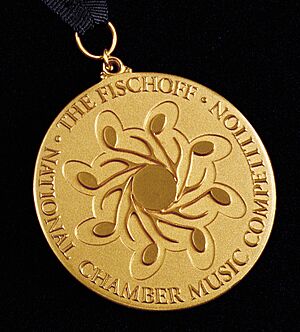Fischoff National Chamber Music Competition facts for kids
The Fischoff National Chamber Music Competition is a big and old music contest in the United States. It's all about chamber music, which is music played by a small group of musicians.
The competition started in 1973. A man named Joseph E. Fischoff and his friends wanted to help young people learn and play chamber music. The very first contest had only six groups. Today, about 125 groups from 22 different countries join in!
Musicians compete in two main types: string instruments (like violins) and wind instruments (like flutes). Fischoff is special because it has two age groups. The "junior" division is for musicians aged 18 and younger. The "senior" division is for those aged 18 to 35.
Over 6,600 musicians have taken part in Fischoff. Many of them have become famous musicians or teachers. Winning an award at Fischoff is a really big deal for young musicians worldwide.
What Happens at the Competition?
The Fischoff competition happens every year. It takes place at the University of Notre Dame in Indiana. The event usually runs for three days in May. For example, the 45th competition was held from May 11 to 13, 2018.
Fischoff really cares about helping musicians learn. Judges give written notes and talk to the competitors. This helps them get better at playing music. Young musicians in the junior division can also attend special master classes. These classes are like advanced lessons from expert musicians.
There is a total of $34,000 in prize money given out. The groups that win the top awards in the senior division also get to go on a special "Double Gold Tour." This tour lets them perform in different places.
Beyond the Competition: Music for Everyone
The Fischoff National Chamber Music Association does more than just run the competition. They work with past competitors to bring free music programs to kids. This program is called the Fischoff Arts-in-Education Residency.
Talented musicians visit schools, libraries, and community centers. They perform for children who might not often hear live classical music. They also interact with the kids, making music fun and accessible.
Fischoff also has programs for high school musicians in the area. These programs help them grow their musical skills. Since 1995, these programs have reached over 58,000 children. Every year, more than 6,000 young people get to experience these special music events.


